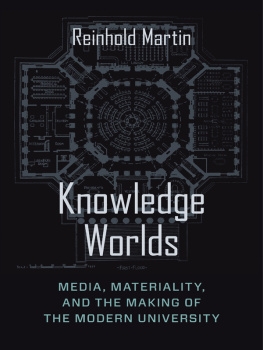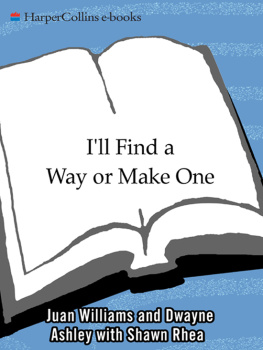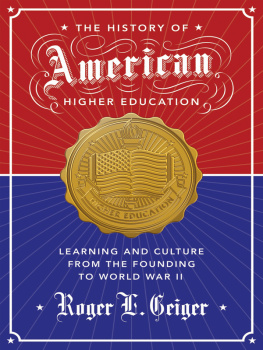Table of Contents
Knowledge Worlds
Columbia University Press
Publishers Since 1893
New York Chichester, West Sussex
cup.columbia.edu
Copyright 2021 Columbia University Press
All rights reserved
E-ISBN 978-0-231-54857-1
Library of Congress Cataloging-in-Publication Data
Names: Martin, Reinhold, 1964 author.
Title: Knowledge worlds: media, materiality, and the making of the modern
university / Reinhold Martin.
Description: New York City: Columbia University Press, 2021. |
Includes bibliographical references and index.
Identifiers: LCCN 2020028433 (print) | LCCN 2020028434 (ebook) |
ISBN 9780231189828 (hardback) | ISBN 9780231189835 (trade paperback) |
ISBN 9780231548571 (ebook)
Subjects: LCSH: Education, HigherPhilosophy. |
Classification: LCC LB2322.2 .M3677 2021 (print) | LCC LB2322.2 (ebook) |
DDC 378.001dc23
LC record available at https://lccn.loc.gov/2020028433
LC ebook record available at https://lccn.loc.gov/2020028434
A Columbia University Press E-book.
CUP would be pleased to hear about your reading experience with this e-book at .
Cover image: William Hallock and Charles F. McKim, Illumination of main
reading room, Low Memorial Library, Columbia University, c. 1897.
Plan Showing Position of Lamps, Dome, and Globe. From Hallock,
Diffused Illumination, Progressive Age 16, no. 3 (1 March 1 1898): 109.
For Neelan, and in memory of Reinhold Ilmar Martin
(Baltic University, 19461949)
CONTENTS
H ow to understand the long, recursive passage in university discourse from liberal to neoliberal reason? Within what material infrastructures, what ways of organizing space and time, regulated by what representations, what poetics, have systems of academic knowledge formed? To what regimes of power, what dialectics of mastery and subordination, what distributions of value, do these infrastructures belong? By what symbolic and political economy of media, technics, and intellectual life, in short, has the modern university been governed?
Animated by such questions, this book opens in several directions. The first, signaled in the subtitle, puts the accent on media. This identifies Knowledge Worlds as a contribution to the history of infrastructural media, or media complexes, with the modern university as its central object. Over the decade or so during which I have researched and written the book, I have conceived of it primarily in these terms, and I still do. Media, broadly construed, take center stage as social and technological systems. Writing from in-between fixed topoi like academic disciplines, institutions, and their guiding concepts, I have tried to show how specific media complexes have enabled, constrained, and otherwise defined the freedom to know, the freedom to learn, and the freedom to teach.
A second reading places the accent slightly differently, on university, as in the making of the modern university. This locates the book among works of intellectual and institutional history and in the history of higher education, especially those that have taken universities or particular aspects of universities or colleges as their subject matter. Many of the books that have filled my shelves during this time belong to these areas, and I have frequently relied on the foundations these works have laid. I hope that this book will take its place among them, if only (in some cases) as a rejoinder.
A third reading concerns what is modern about universities and the media by which they are shaped. A provincialism masked in the subtitlethe modern universityis that the colleges and universities that Knowledge Worlds considers are all located in the United States, and most of the hardware that constitutes their media complexes is American-made. This might lend credence to the metonymic fallacy that allows America (or Euro-America) and all things American (or Western) to stand for modernity as such.
My hypothesis instead is that the hegemonic microcosm I study herethe American universityrefracts the variegated macrocosm, which includes its counterparts around the world. Putting U.S. colleges and universities under the microscope highlights the boundary problems that have defined them, the recurrent efforts to make worlds inside their walls distinct from those outside even while connecting the two. For what is modern about colleges and universities in the United States from about 1800 to about 1975 is so by virtue of the particular ways in which their numerous gates, passages, and thresholdsboth spatial and temporalhave secured knowledge, consolidated power, and laid claim on universality through the regular, carefully orchestrated opening and closing of doors.
Lurking within these readings of the book is the difference between a university and a college, each of which generally serves different constituents to different ends. Rather than accept this difference as categorical, I have tried to show it in formation. In the United States, colleges most often preceded universities and sometimes grew into them. But the transformation of one into the other was rarely straightforward, just as the persistence of some traits and the introduction of others rarely followed a predictable path. In all cases, my main concern has been the line that distinguishes and joins the two, diachronically and synchronically. Whether it is a history of media or of universities, then, this book is a history of differences, inequalities, connections, and continuities in the production, storage, and transmission of knowledge.
Finally, there is the matter of the subjects who make this history even as they are made by it. Throughout I emphasize the making, which like all construction requires tools. From books to buildings, material things mediate countless acts of knowledge-making thatin each caserecursively define their makers. Knowledge Worlds is about these human agents and their degrees of agency, just as much as it is about the hardware that enables them to know, and to be recognized in turn as knowing subjects who operate that hardware.
For a book like this, the authors disciplinary orientation should be especially consequential. Mine begins with the history of architecture. Despite its institutional location in schools of architecture and in departments of art history, the history of architectureor architectural historyis, as I conceive it, of a piece with historical scholarship in general, not a separate domain. Media history is a history of such connections. Still, the architectural historian brings certain tools to the job site. Time spent walking around campuses, poking around their buildings, and examining visual documents has been especially important. Unmentioned in the title, architecture is everywhere in the book. Yet what I have written about is frequently unseen: the infrastructures that pass through more visible or legible structures. Historians of architecture may therefore find some expectations of their craft unmet. My hope nonetheless is that a patient reading will show how doing history with architecture reanimates the languages of space, form, utility, and meaning that have been refined by generations of scholars to whom I am silently indebted.








